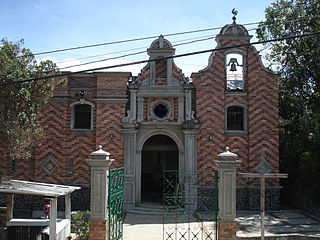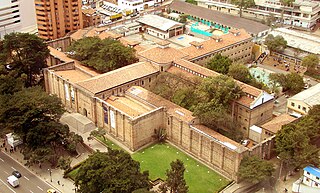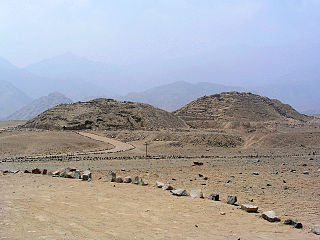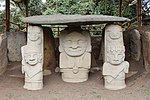The history of Colombia includes the settlements and society by indigenous peoples, most notably, the Muisca Confederation, Quimbaya Civilization, and Tairona Chiefdoms; the Spanish arrived in 1492 and initiated a period of annexation and colonization, most noteworthy being Spanish conquest; ultimately creating the Viceroyalty of New Granada, with its capital at Bogotá. Independence from Spain was won in 1819, but by 1830 the "Gran Colombia" Federation was dissolved. What is now Colombia and Panama emerged as the Republic of New Granada. The new nation experimented with federalism as the Granadine Confederation (1858), and then the United States of Colombia (1863), before the Republic of Colombia was finally declared in 1886; as well as constant political violence in the country. Panama seceded in 1903. Since the 1960s, the country has suffered from an asymmetric low-intensity armed conflict, which escalated in the 1990s, but then decreased from 2005 onward. The legacy of Colombia's history has resulted in a rich cultural heritage; while varied geography, and the imposing landscape of the country has resulted in the development of very strong regional identities.

The Muisca are an indigenous people and culture of the Altiplano Cundiboyacense, Colombia, that formed the Muisca Confederation before the Spanish conquest. The people spoke Muysccubun, a language of the Chibchan language family, also called Muysca and Mosca. They were encountered by conquistadors dispatched by the Spanish Empire in 1537 at the time of the conquest. Subgroupings of the Muisca were mostly identified by their allegiances to three great rulers: the hoa, centered in Hunza, ruling a territory roughly covering modern southern and northeastern Boyacá and southern Santander; the psihipqua, centered in Muyquytá and encompassing most of modern Cundinamarca, the western Llanos; and the iraca, religious ruler of Suamox and modern northeastern Boyacá and southwestern Santander.
Classical archaeology is the archaeological investigation of the Mediterranean civilizations of Ancient Greece and Ancient Rome. Nineteenth-century archaeologists such as Heinrich Schliemann were drawn to study the societies they had read about in Latin and Greek texts. Many universities and foreign nations maintain excavation programs and schools in the area – such is the enduring appeal of the region's archaeology.

Gerardo Reichel-Dolmatoff was an Austrian anthropologist and archaeologist. He is known for his fieldwork among many different Amerindian cultures such as in the Amazonian tropical rainforests, and also among dozens of other indigenous groups in Colombia in the Caribbean Coast, as well as others living in the Pacific Coast, Llanos Orientales, and in the Andean and inter-Andean regions (Muisca) as well as in other areas of Colombia, and he also did research on campesino societies. For nearly six decades he advanced ethnographic and anthropological studies, as well as archeological research, and as a scholar was a prolific writer and public figure renowned as a staunch defender of indigenous peoples. Reichel-Dolmatoff has worked with other archaeologists and anthropologists such as Marianne Cardale de Schrimpff, Ana María Groot, Gonzalo Correal Urrego and others. He died 17 May 1994 in Colombia.

The Museum of Gold is an archaeology museum located in Bogotá, Colombia. It is one of the most visited touristic highlights in the country. The museum receives around 500,000 tourists per year.

The Erligang culture is a Bronze Age urban civilization and archaeological culture in China that existed from approximately 1600 to 1400 BC. The primary site, Zhengzhou Shang City, was discovered at Erligang, within the modern city of Zhengzhou, Henan, in 1951.

The Museo Casa de Moneda is a numismatics museum located in La Candelaria neighborhood of Bogotá, Colombia. It is managed by the Bank of the Republic of Colombia and used to display its numismatic collection that is composed by around 18,600 objects that include artwork, banknotes, bonds, coins, derivatives, medals, negotiable instruments, and printing instruments from various periods and regions of the world.

The National Museum of Colombia is the National Museum of Colombia housing collections on its history, art, culture. Located in Bogotá downtown, is the biggest and oldest museum in Colombia. The National Museum of Colombia is a dependency of the Colombian Ministry of Culture.

Colombian art has 3500 years of history and covers a wide range of media and styles ranging from Spanish Baroque devotional painting to Quimbaya gold craftwork to the "lyrical americanism" of painter Alejandro Obregón (1920–1992). Perhaps the most internationally acclaimed Colombian artist is painter and sculptor Fernando Botero (1932).

Piedras del Tunjo is an important archaeological park established on a natural rock shelter 40 kilometres (25 mi) west of Bogotá in the municipality of Facatativá.

The following outline is provided as an overview of and topical guide to Colombia:

El Infiernito, is a pre-Columbian archaeoastronomical site located on the Altiplano Cundiboyacense in the outskirts of Villa de Leyva, Boyacá, Colombia. It is composed of several earthworks surrounding a setting of menhirs ; several burial mounds are also present. The site was a center of religious ceremonies and spiritual purification rites, and also served as an astronomical observatory.

The Andean civilizations were South American complex societies of many indigenous people. They stretched down the spine of the Andes for 4,000 km (2,500 mi) from southern Colombia, to Ecuador and Peru, including the deserts of coastal Peru, to north Chile and northwest Argentina. Archaeologists believe that Andean civilizations first developed on the narrow coastal plain of the Pacific Ocean. The Caral or Norte Chico civilization of coastal Peru is the oldest known civilization in the Americas, dating back to 3500 BCE. Andean civilization is one of the six "pristine" civilizations of the world, created independently and without influence by other civilizations.

The National monuments of Colombia are the set of properties, nature reserves, archaeological sites, historic districts, urban areas and property that, for values of authenticity, originality, aesthetics, and artistic techniques, are representative of Colombia and constitute core elements of its history and culture. The cultural heritage of Colombia includes material and immaterial assets "which are an expression of the Colombian nationality", in accordance with Law No. 1185 (2008). As of December 2011, 1079 National Monuments have been declared. A further sixteen candidate sites have been identified for future declaration.

The Andean preceramic refers to the early period of human occupation in the Andean area of South America that preceded the introduction of ceramics. This period is also called pre-ceramic or aceramic.

The Muisca inhabited the Altiplano Cundiboyacense in the Colombian Andes before the arrival of the Spanish and were an advanced civilisation. They mummified the higher social class members of their society, mainly the zipas, zaques, caciques, priests and their families. The mummies would be placed in caves or in dedicated houses ("mausoleums") and were not buried.
Tibitó is the second-oldest dated archaeological site on the Altiplano Cundiboyacense, Colombia. The rock shelter is located in the municipality Tocancipá, Cundinamarca, Colombia, in the northern part of the Bogotá savanna. At Tibitó, bone and stone tools and carbon have been found. Bones from Haplomastodon, Cuvieronius, Cerdocyon and white tailed deer from the deepest human trace containing layer of the site is carbon dated to be 11,740 ± 110 years old. The oldest dated sediments are lacustrine clays from an ancient Pleistocene lake.

The San Agustín culture is one of the ancient Pre-Columbian cultures of Colombia. Its beginnings go back at least to the fourth millennium B.C. Several hundred large monolithic sculptures have been found here.

The pre-Columbian cultures of Colombia refers to the ancient cultures and civilizations that inhabited Colombia before the Spanish Conquest in the 16th century.






















